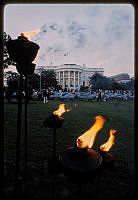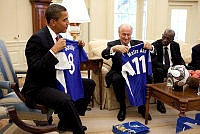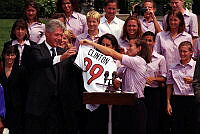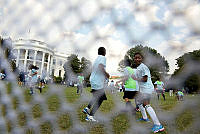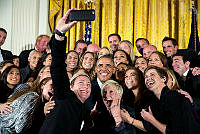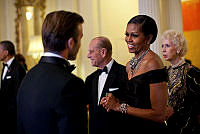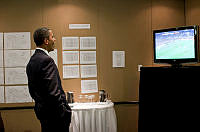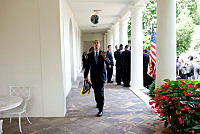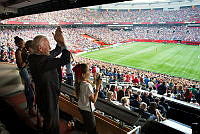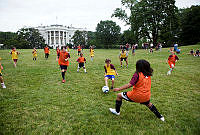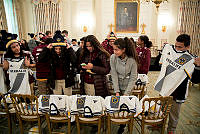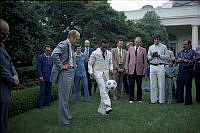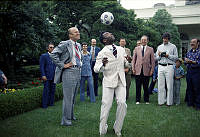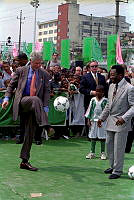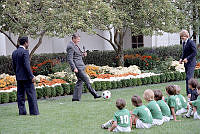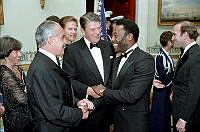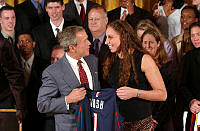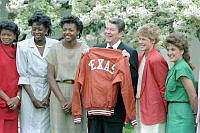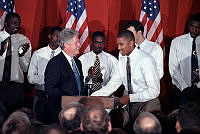Rubenstein Center Scholarship
The “Miracle on Ice”
Winter Olympic Champions at the White House
After the end of World War II, the United States and the Soviet Union became locked in a global battle for economic, political, and cultural dominance. This rivalry touched on many different facets of life—social and political issues, national security, international relations, popular culture, and even sports—including the Olympic Games. Athletes from the world’s two superpower countries competed against each another for medals, accolades, and pride for decades. The 1980 Winter Olympics unfolded within this national and international context, which made the “Miracle on Ice” all the more dramatic and one of the greatest moments in American sports history.

This illustration of the "Miracle on Ice" was gifted to President Jimmy Carter by Team USA Head Coach Herb Brooks after visiting the White House in 1980. The artwork resides within the collection of the Carter Library.
Jimmy Carter Presidential Library and Museum/NARAOn January 20, 1980, President Jimmy Carter announced that he would not support sending American athletes to Moscow for the Summer Olympic Games because of the Soviet invasion of Afghanistan. In his State of the Union Address three days later, President Carter listed his administration’s response to the Soviets’ actions—economic penalties, restricting fishing permits for Soviet ships in coastal waters of the U.S., and limiting access to American technology and agricultural products. He concluded, “And I have notified the Olympic Committee that with Soviet invading forces in Afghanistan, neither the American people nor I will support sending an Olympic team to Moscow.”1 While the decision to send athletes rested solely with the Olympic Committee, it appeared that the United States would not participate in the Summer Games.2 Less than a month after Carter’s announcement, athletes were competing on the international stage at Lake Placid, New York in the XIII Olympic Winter Games. With tensions growing between the United States and the Soviet Union, spectators across the country and around the world watched eagerly as American and Soviet athletes battled for athletic supremacy.
In the sport of hockey, the Americans had not won a gold medal since 1960, when the games were hosted at Squaw Valley, California. The Soviet hockey team dominated the 1964, 1968, 1972, and 1976 games, winning four consecutive gold medals. The 1980 U.S. Olympic Team, led by legendary Minnesota Gophers hockey coach Herb Brooks, consisted mostly of college players instead of professional athletes.3 The team improved steadily over the course of their 60-game exhibition schedule, but their final game came on February 9, 1980. In a much anticipated matchup at Madison Square Garden, the Soviets routed the Americans 10-3 in front of 11,000 spectators. Coach Brooks was frank in his assessment: “I’ve got to mix idealism with practicality. Our changes for a gold medal are very slim, if none at all. If we can win a bronze this year, it’ll be like winning the gold medal in 1960.”4

Taken on February 25, 1980, this photograph shows President Jimmy Carter speaking on the South Portico. The president is surrounded by Winter Olympians, including members of the Men's Hockey team. President Carter and First Lady Rosalynn Carter hosted approximately 150 athletes for a reception at the White House that day.
Courtesy of Twitter @1980MiracleTeam/Jimmy Carter Presidential Library and Museum/NARAThe Americans were seeded seventh in the pool of twelve teams for the Olympics—their lackluster performance against the Soviets had cast them as inexperienced and ill-prepared for this level of competition. The underdog team tied a heavily-favored Sweden, 2-2, upset Czechoslovakia, and then went on to beat Norway, Romania, and West Germany, finishing the first round 4-0-1. The U.S. advanced to the medal round to face the Soviet Union, and in a shocking upset the Americans came from behind to defeat the Soviets, 4-3. The final (and winning) goal was scored by team captain Mike Eruzione, and goalie Jim Craig held off the Soviet offensive onslaught during the final ten minutes. President Carter phoned Brooks from Camp David to offer his congratulations after the game—he also extended an invitation to visit the White House. According to Carter’s recollection, Brooks responded, “Mr. President, we've got another game to play Sunday morning, and I can't promise that we'll come until we see how that event goes…after the Olympics are over, I think there are some buses that will be available at Lake Placid to bring us to the White House.” President Carter laughed and replied, "If you don't mind, Herb, I think I'll send a couple of planes to pick you up."5

President Jimmy Carter and First Lady Rosalynn Carter pose for a photograph with Team USA Captain Mike Eruzione in the Blue Room.
Courtesy of Twitter @1980MiracleTeam/Jimmy Carter Presidential Library and Museum/NARAOn February 24, the Americans faced a tough Finland squad for the gold medal. Trailing 2-1 going into the second intermission, Brooks implored his team to finish what they had started, or they would regret it for the rest of their lives. The American offense came alive, scoring three goals in the third period. The American hockey team had not only stunned the Soviets but also the world with its first gold medal since 1960.6 True to his word, President Carter sent Air Force military planes, including Air Force One, to pick up the Olympic athletes and bring them to Washington, D.C., where they were greeted by thousands of cheering Americans waving flags and signs.7 The next day, President Carter and First Lady Rosalynn Carter hosted the Olympic athletes at the White House for a luncheon. The president acknowledged both the “Miracle on Ice” hockey team and others such as speed skaters Eric and Beth Heiden, figure skaters Linda Fratianne and Charlie Tickner, speed skater Leah Poulos Mueller, and skier Phil Mahre. President Carter declared that “this is one of the proudest moments that I've ever experienced. These are wonderful young Americans, and they have thrilled our Nation. And we're all deeply grateful for your tremendous achievements.”8

Several members of the men's hockey team enjoy plates of food in the State Dining Room during a reception held for Winter Olympians on February 25, 1980.
Courtesy of Twitter @1980MiracleTeam/Jimmy Carter Presidential Library and Museum/NARA













